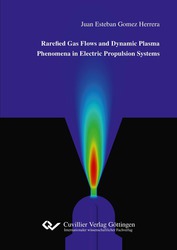| Areas | |
|---|---|
| Serie de libros (96) |
1378
|
| Nachhaltigkeit |
3
|
| Gesundheitswesen |
1
|
| Letra |
2363
|
| Ciencias Naturales |
5406
|
| Matemática | 229 |
| Informática | 319 |
| Física | 980 |
| Química | 1363 |
| Geociencias | 131 |
| Medicina humana | 243 |
| Estomatología | 10 |
| Veterinaria | 108 |
| Farmacia | 147 |
| Biología | 835 |
| Bioquímica, biología molecular, tecnología genética | 121 |
| Biofísica | 25 |
| Nutrición | 45 |
| Agricultura | 1004 |
| Silvicultura | 201 |
| Horticultura | 20 |
| Ecología y conservación de la tierra | 148 |
| Ciencias Ingeniería |
1791
|
| General |
98
|
|
Leitlinien Unfallchirurgie
5. Auflage bestellen |
|
Erweiterte Suche
Rarefied Gas Flows and Dynamic Plasma Phenomena in Electric Propulsion Systems (Tienda española)
Juan Esteban Gomez Herrera (Autor)Previo
Lectura de prueba, PDF (250 KB)
Indice, PDF (79 KB)
Zu den aktuellen Entwicklungen in der Raumfahrtindustrie zählen das stetig wachsende Interesse an miniaturisierten Satelliten sowie der immer häufigere Einsatz elektrischer Antriebssysteme zu allgemeinen Lage- und Bahnregelungszwecken. Die Entwicklung miniaturisierter Satelliten erfordert ihrerseits den Einsatz von Antriebssystemen, die sehr kleine und präzise zu steuernde Schubkräfte erzeugen. Vor diesem Hintergrund stellen elektrische Triebwerke eine attraktive Option dar, die Antriebsanforderungen von Satelliten sowohl in herkömmlichen als auch in miniaturisierten Größen langfristig zu erfüllen. Bei miniaturisierten Satelliten sind die Schubanforderungen oft mit niedrigen Treibstoff-Massenstromwerten und verhältnismäßig kleinen geometrischen charakteristischen Längen verbunden. Dies kann zu verdünnten Gaszuständen innerhalb der Triebwerksdüsen führen. Wegen der hohen Komplexität der Plasmaphänomene innerhalb elektrischer Triebwerke sowie der typischerweise hohen Rechenanforderungen, die mit der Plasmamodellierung einhergehen, werden elektrische Antriebssysteme oft auf Basis empirischer Modelle und experimenteller Daten entwickelt. Der Fokus der vorliegenden Arbeit liegt auf den oben beschriebenen Herausforderungen und den dazugehörigen Forschungsfeldern: der Untersuchung verdünnter Gaszustände in transsonischen Strömungen sowie der Entwicklung numerischer Modellierungsansätze zur Beschreibung des Plasmaverhaltens innerhalb elektrischer Antriebssysteme.
New trends regarding fundamental design approaches of orbital spacecraft have been developing in the space industry in recent years. They include an increased interest in miniaturized satellites as well as a general rise in the use of electric propulsion systems for orbit and attitude control. The successful implementation of miniaturized satellites requires the use of propulsion devices able to provide small and precise thrust and impulse levels. One technical solution able to meet the requirements of both standard-sized as well as miniaturized spacecraft involves the use of highly efficient and precise electric propulsion systems. In the particular case of miniaturized satellites, the propulsion requirements are often associated with low propellant mass flow rates and small characteristic geometrical lengths, potentially leading to the appearance of rarefied conditions inside the nozzles of the propulsion devices. Because of the high complexity of the plasma phenomena taking place inside such systems and the usually very high computational requirements associated with their numerical modelling, electric propulsion systems for space applications are usually designed based on empirical models and experimental data. The present work focuses on two key aspects outlined above: rarefied gas conditions in transonic micronozzle flows as well as the numerical modelling of plasma phenomena inside electric propulsion systems.
| ISBN-13 (Impresion) | 9783736973244 |
| ISBN-13 (E-Book) | 9783736963245 |
| Formato | A5 |
| Idioma | Inglés |
| Numero de paginas | 368 |
| Laminacion de la cubierta | mate |
| Edicion | 1 |
| Lugar de publicacion | Göttingen |
| Fecha de publicacion | 04.01.2021 |
| Clasificacion simple | Tesis doctoral |
| Area |
Física
Física atómica y molecular, física plasma y de gases Ingeniería Mecánica de medida Ingeniería mecánica y de proceso Ingeniería aeroespacial |
| Palabras claves | Transonic flows, Flow regimes, Rarefied gas flows, Electric propulsion, Space flight, Satellites, Laval nozzle, Plasma modelling, Kinetic gas modelling, Fluid dynamics, CFD, Continuum approaches, DSMC, Monte-Carlo collisions, Particle-In-Cell method, OpenFOAM, Transsonische Strömungen, Strömungsbereiche, Verdünnte Gaszustände, Elektrische Antriebssysteme, Raumfahrt, Satelliten, Lavaldüse, Plasmamodellierung, Kinetische Gasmodellierung, Strömungsmechanik, CFD, Kontinuumsansätze, DSMC, Monte-Carlo-Kollisionen, Particle-In-Cell-Methode, OpenFOAM, Raumfahrtindustrie, space industry, Antriebssysteme, drive systems, Schubkraft, thrust, Triebwerk, power unit, Triebwerksdüsen, engine nozzles, Gaszustände, gas states, Kaltgas, cold gas, Edelgas, noble gas, Brennkammer, combustion chamber, Knudsen-Zahl, Knudsen number, Knudsen-Funktion, Knudsen function, Energieaustausch, energy exchange, Elektronenstrahlbehandlung, electron beam treatment, Schallgeschwindigkeit, speed of sound, Knudsen-Koeffizient, Knudsen coefficient, Maxwell-Verteilung, Maxwell distribution, Stromdichte, current density, Wärmeleitfähigkeit, thermal conductivity, Heizleistung, heating power, Zufallszahl, random number, Volumenviskosität, viscosity, Raumfahrzeug, spacecraft, Plasmaphänomen, Plasmaphysik, plasma physic, Kollisionsquerschnitt, Gasverdünnung, gas rarefaction, Druckabfall, pressure drop |
| URL para pagina web externa | https://www.zarm.uni-bremen.de/ |








